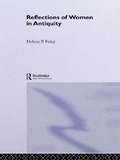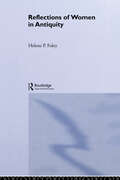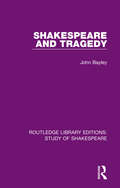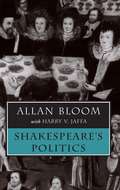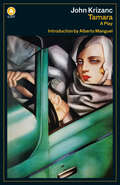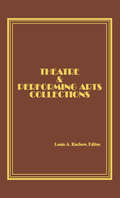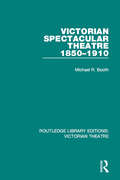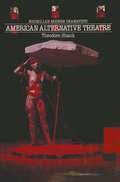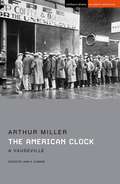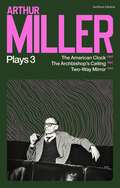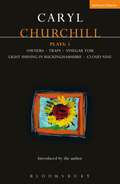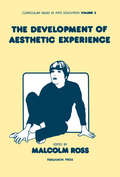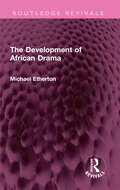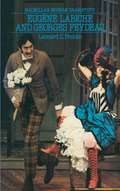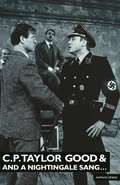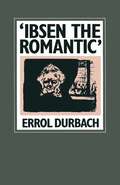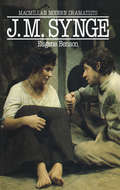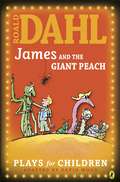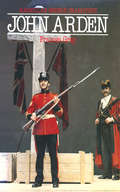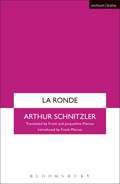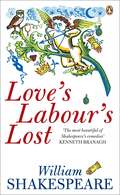- Table View
- List View
Reflections of Women in Antiquity
by Helene FoleyPublished in the year 1981, Reflections of Women in Antiquity is a valuable contribution to the field of Performance.
Reflections of Women in Antiquity
by Helene FoleyPublished in the year 1981, Reflections of Women in Antiquity is a valuable contribution to the field of Performance.
Shakespeare and Tragedy (Routledge Library Editions: Study of Shakespeare)
by John BayleyEvery generation develops its own approach to tragedy, attitudes successively influenced by such classic works as A. C. Bradley’s Shakespearean Tragedy and the studies in interpretation by G. Wilson Knight. A comprehensive new book on the subject by an author of the same calibre was long overdue. In his book, originally published in 1981, John Bayley discusses the Roman plays, Troilus and Cressida and Timon of Athens as well as the four major tragedies. He shows how Shakespeare’s most successful tragic effects hinge on an opposition between the discourses of character and form, role and context. For example, in Lear the dramatis personae act in the dramatic world of tragedy which demands universality and high rhetoric of them. Yet they are human and have their being in the prosaic world of domesticity and plain speaking. The inevitable intrusion of the human world into the world of tragedy creates the play’s powerful off-key effects. Similarly, the existential crisis in Macbeth can be understood in terms of the tension between accomplished action and the free-ranging domain of consciousness. What is the relation between being and acting? How does an audience become intimate with a protagonist who is alienated from his own play? What did Shakespeare add to the form and traditions of tragedy? Do his masterpieces in the genre disturb and transform it in unexpected ways? These are the issues raised by this lucid and imaginative study. Professor Bayley’s highly original rethinking of the problems will be a challenge to the Shakespearean scholar as well as an illumination to the general reader.
Shakespeare and Tragedy (Routledge Library Editions: Study of Shakespeare)
by John BayleyEvery generation develops its own approach to tragedy, attitudes successively influenced by such classic works as A. C. Bradley’s Shakespearean Tragedy and the studies in interpretation by G. Wilson Knight. A comprehensive new book on the subject by an author of the same calibre was long overdue. In his book, originally published in 1981, John Bayley discusses the Roman plays, Troilus and Cressida and Timon of Athens as well as the four major tragedies. He shows how Shakespeare’s most successful tragic effects hinge on an opposition between the discourses of character and form, role and context. For example, in Lear the dramatis personae act in the dramatic world of tragedy which demands universality and high rhetoric of them. Yet they are human and have their being in the prosaic world of domesticity and plain speaking. The inevitable intrusion of the human world into the world of tragedy creates the play’s powerful off-key effects. Similarly, the existential crisis in Macbeth can be understood in terms of the tension between accomplished action and the free-ranging domain of consciousness. What is the relation between being and acting? How does an audience become intimate with a protagonist who is alienated from his own play? What did Shakespeare add to the form and traditions of tragedy? Do his masterpieces in the genre disturb and transform it in unexpected ways? These are the issues raised by this lucid and imaginative study. Professor Bayley’s highly original rethinking of the problems will be a challenge to the Shakespearean scholar as well as an illumination to the general reader.
Shakespeare's Politics
by Allan BloomTaking the classical view that the political shapes man's consciousness, Allan Bloom considers Shakespeare as a profoundly political Renaissance dramatist. He aims to recover Shakespeare's ideas and beliefs and to make his work once again a recognized source for the serious study of moral and political problems. In essays looking at Julius Caesar, Othello, and The Merchant of Venice, Bloom shows how Shakespeare presents a picture of man that does not assume privileged access for only literary criticism. With this claim, he argues that political philosophy offers a comprehensive framework within which the problems of the Shakespearean heroes can be viewed. In short, he argues that Shakespeare was an eminently political author. Also included is an essay by Harry V. Jaffa on the limits of politics in King Lear. "A very good book indeed . . . one which can be recommended to all who are interested in Shakespeare." —G. P. V. Akrigg "This series of essays reminded me of the scope and depth of Shakespeare's original vision. One is left with the impression that Shakespeare really had figured out the answers to some important questions many of us no longer even know to ask."-Peter A. Thiel, CEO, PayPal, Wall Street Journal Allan Bloom was the John U. Nef Distinguished Service Professor on the Committee on Social Thought and the co-director of the John M. Olin Center for Inquiry into the Theory and Practice of Democracy at the University of Chicago. Harry V. Jaffa is professor emeritus at Claremont McKenna College and Claremont Graduate School.
Tamara
by John KrizancAvailable for the first time in over thirty years, John Krizanc’s internationally acclaimed play redefined the limits of theatre with its haunting tale of art, sex, violence, and political intrigue in Fascist Italy. In the late twenties the poet, war hero, and lothario Gabriele d’Annunzio waits in his opulent villa — a gift from Benito Mussolini in return for his political silence — for the arrival of the artist Tamara de Lempicka, who is to paint his portrait. What follows is a tale of art, sex, violence and the meaning of complicity in an authoritarian state. The action is directed by the reader/audience member, who decides which characters to follow and which narratives to experience. John Krizanc’s masterpiece redefined theatre and won six L.A. Drama Critics Circle Awards, six Dora Mavor Moore Awards, six Drama-Logue Awards, and six Mexican Association of Theatre Critics, and Journalists Awards for its original productions. Now available in a handsome new A List edition, Tamara is an astonishing piece of experimental art and a penetrating look into ethical choices in times of encroaching autocracy.
Theatre and Performing Arts Collections
by Lee AshHere is an exciting book that provides detailed descriptions of dozens of the most important and unique collections of “theatricana” in the United States and Canada. In Theatre and Performing Arts Collections, distinguished theatre specialists, librarians, and curators describe the unique possessions of the best and largest collections in theatre and performing arts. Each chapter provides detailed descriptions of the collections, as well as important notes about their history--information that is not available in any other source!
Theatre and Performing Arts Collections
by Lee AshHere is an exciting book that provides detailed descriptions of dozens of the most important and unique collections of “theatricana” in the United States and Canada. In Theatre and Performing Arts Collections, distinguished theatre specialists, librarians, and curators describe the unique possessions of the best and largest collections in theatre and performing arts. Each chapter provides detailed descriptions of the collections, as well as important notes about their history--information that is not available in any other source!
Victorian Spectacular Theatre 1850-1910 (Routledge Library Editions: Victorian Theatre)
by Michael R. BoothOriginally published in 1981. This study concentrates on one aspect of Victorian theatre production in the second half of the nineteenth century – the spectacular, which came to dominate certain kinds of production during that period. A remarkably consistent style, it was used for a variety of dramatic forms, although surrounded by critical controversy. The book considers the theories and practice of spectacle production as well as the cultural and artistic movements that created the favourable conditions in which spectacle could dominate such large areas of theatre for so many years. It also discusses the growth of spectacle and the taste of the public for it, examining the influence of painting, archaeology, history, and the trend towards realism in stage production. An explanation of the working of spectacle in Shakespeare, pantomime and melodrama is followed by detailed reconstructions of the spectacle productions of Irving’s Faust and Beerbohm Tree’s King Henry VIII.
Victorian Spectacular Theatre 1850-1910 (Routledge Library Editions: Victorian Theatre)
by Michael R. BoothOriginally published in 1981. This study concentrates on one aspect of Victorian theatre production in the second half of the nineteenth century – the spectacular, which came to dominate certain kinds of production during that period. A remarkably consistent style, it was used for a variety of dramatic forms, although surrounded by critical controversy. The book considers the theories and practice of spectacle production as well as the cultural and artistic movements that created the favourable conditions in which spectacle could dominate such large areas of theatre for so many years. It also discusses the growth of spectacle and the taste of the public for it, examining the influence of painting, archaeology, history, and the trend towards realism in stage production. An explanation of the working of spectacle in Shakespeare, pantomime and melodrama is followed by detailed reconstructions of the spectacle productions of Irving’s Faust and Beerbohm Tree’s King Henry VIII.
The American Clock: A Vaudeville (Student Editions)
by Arthur Miller'It is Mr. Miller's notion, potentially a great one, that the Baums' story can help tell the story of America itself during that traumatic era.'NEW YORK TIMESWhen the stock market crashes, the once-financially comfortable Baum family lose everything and are forced to leave their lofty home in Manhattan to live with relatives in Brooklyn: how can their pride, purpose and artistic endeavours survive such a sudden and shocking reversal of fortune?A sweeping, hard-hitting look at the Great Depression of the 1930s, The American Clock is a vaudevillian celebration of American resilience and optimism in the face of national crisis, and was performed on Broadway in 1980.This Methuen Drama Student Edition is edited by Jane K. Dominik, with commentary and notes that explore the play's production history (including excerpts from interviews with designers of the 1980 Broadway production) as well as the dramatic, thematic and academic debates that surround it.
Arthur Miller Plays 3: The American Clock; The Archbishop's Ceiling; Two-Way Mirror
by Arthur Miller"The greatest American dramatist of our age" - Evening Standard In this third volume of collected works, three of Arthur Miller's stage plays from the early 1980s are brought together in a new edition. Expanding on the themes and explorations of his earlier work, this volume also contains an introduction from the playwright himself, as well as an afterword by acclaimed Miller scholar Christopher Bigsby. A sweeping, hard-hitting look at the Great Depression of the 1930s, The American Clock(1982) is a vaudevillian celebration of American resilience and optimism in the face of national crisis, and was later performed on Broadway. Set in an Eastern European capital, The Archbishop's Ceiling (1984), examines the relationship between four writers, and the erosion of personal integrity during the cold war: a thrilling study of the effects of surveillance and political pressure on an individual's actions Also included is a revised version of Two-Way Mirror (1984): a double bill for a man and a woman, consisting of two short plays - Elegy for a Lady and Some Kind of Love Story. These fantastic two-handers explore the nuances in relationships, and have come to be come to be recognised as some sort of coded epitaph to the tumult and tragedy of Miller's marriage to Marilyn Monroe Freshly edited and featuring a bold new design, this updated edition of Arthur Miller Plays 3 is a must-have for theatre fans and students alike.
Churchill Plays: Owners; Traps; Vinegar Tom; Light Shining in Buckinghamshire; Cloud Nine (Contemporary Dramatists)
by Caryl ChurchillIn Traps, a set of characters meet themselves and their pasts to create "plenty of sinewy lines and joyous juxtapostions" (Plays and Players); Vinegar Tom "is set in the world of seventeenth-century witchcraft, but it speaks, through its striking images and its plethora of ironic contradictions, of and to this century..." (Tribune); Light Shining in Buckinghamshire is set during the Civil War and "unflinchingly shows the intolerance that was the obverse side of the demand for common justice. Deftly, it sketches in the kind of social conditions.. that led to hunger for revolution...The play has an austere eloquence that precisely matches its subject." (The Guardian) Cloud Nine sheds light on some of the British Empire's repressed dark side and is "a marvelous play - sometimes scurrilous, always observed with wicked accuracy, and ultimately, surprisingly, rather moving. It plunges straight to the heart of the endless convolutions of sexual mores...and does so with acrobatic wit." (Guardian) Owners:"I was in an old woman's flat when a young man offering her money to move came round, that was one of the starting points of the play" (Caryl Churchill).The plays in this volume represent the best of Churchill's writing up to and including her emergence onto the international theatre scene with Cloud Nine.
The Development of Aesthetic Experience: Curriculum Issues in Arts Education
by Malcolm RossCurriculum Issues in Arts Education, Volume 3: The Development of Aesthetic Experience focuses on the processes, methodologies, and approaches involved in the development of aesthetic experience, including art education, developmental theories, and aesthetic assessment. The book first tackles the concept of aesthetic development and aesthetic dimension in art education. The text then explores the psychological viewpoint of aesthetic development and aesthetic development in music. Topics include music education, music and function, task of teachers, developmental relationships between processes or roles, and uses and misuses of developmental theories.The publication ponders on the role of teachers and students, aesthetic development in dance, and drama as learning, art, and aesthetic experience. The manuscript then examines emotional development in adolescence, meaning in aesthetic experience, and aesthetic assessment and the reliability factor.The book is a reliable source of information for educators and readers interested in the development of aesthetic experience.
The Development of African Drama (Routledge Revivals)
by Michael EthertonOriginally published in 1982, this book explores concepts such as ‘traditional performance’ and African theatre’. It analyses the links between drama and ritual, and drama and music and diagnoses the confusions in our thought. The reader is reminded that drama is never merely the printed word, but that its existence as literature and in performance is necessarily different. The analysis shows that literature tends to replace performance; and drama, removed from the popular domain, becomes elitist. The book’s richness lies in the constantly stimulating analysis of ‘art’ theatre, as exemplified in protest plays, in African adaptations and transpositions of such classical subjects as the Bacchae and Everyman, in plays on African history, on colonialism and neo-colonialism. The final chapters argue that the form of African drama needs to evolve as the content does.
The Development of African Drama (Routledge Revivals)
by Michael EthertonOriginally published in 1982, this book explores concepts such as ‘traditional performance’ and African theatre’. It analyses the links between drama and ritual, and drama and music and diagnoses the confusions in our thought. The reader is reminded that drama is never merely the printed word, but that its existence as literature and in performance is necessarily different. The analysis shows that literature tends to replace performance; and drama, removed from the popular domain, becomes elitist. The book’s richness lies in the constantly stimulating analysis of ‘art’ theatre, as exemplified in protest plays, in African adaptations and transpositions of such classical subjects as the Bacchae and Everyman, in plays on African history, on colonialism and neo-colonialism. The final chapters argue that the form of African drama needs to evolve as the content does.
'Good' & 'A Nightingale Sang' (Modern Plays)
by C. P. TaylorGood is a story about a liberal-minded university professor who drifts well-meaningly into a position in the upper reaches of the Nazi administration. It is a profound and alarming examination of passivity and the rationalisation of evil.John Halder, a professor of literature, seems to be a good man; he diligently visits his blind and senile mother and looks after his vacant wife and three children. He is unremarkable, other than an unusual neurotic tic: the imaginary sound of band music plays in the background of his life, particularly at moments of high emotion. But by writing a book – the result of his own experience – discussing euthanasia for senile elderly people and by lecturing on the delicacy of German literary culture, John has unintentionally made himself a very desirable acquisition for the Nazi party.By rationalised and intellectually reasoned steps he is absorbed into the direction of the death camps, a transformation all the more chilling because it does not seem dramatic, until the last horrible resounding note of the play.Good is a structured stream of consciousness, punctured by the musical medley that plays inside Halder's head. The first production was staged at the London Warehouse in 1982. And A Nightingale Sang . . . opens on a house in Newcastle-Upon-Tyne filled with well-meant and bustling domestic chaos. Set just before the beginning of the war, the scenes are partly related by Helen, who is stoical and self-deprecating and walks with a limp. Her grandfather Andie is recruiting mourners to attend the burial of his dog; her devout Catholic mother is fretting about the health of the local priest; her father is serenading an unwilling audience with the popular songs that light up the whole play. Joyce, Helen's younger, prettier sister is dithering over whether to accept a marriage proposal from Eric, who is being deployed to France. Helen, depended on for guidance by the whole family, has never had any attention from men – until she meets Norman, who shows her that she can waltz and fall in love. But for all the family, nothing can be the same after the war.And A Nightingale Sang . . . was first staged in 1977 by Live Theatre in Newcastle-Upon-Tyne, and was presented in this version at the Queen's Theatre, London, in 1979.
James and the Giant Peach: Plays for Children
by Richard George Roald DahlJoin James as he escapes from his horrible aunts and sets off inside the peach on his wonderful adventures. This dramatization of Roald Dahl's hugely popular book can be staged in school, acted out at home or simply read together by a group of friends. With suggestions for staging, props and lighting.Roald Dahl died in 1990 but his books continue to be worldwide bestsellers.Richard George was an American elementary school teacher when he adapted James and the Giant Peach as a school play. Roald Dahl loved it and wrote an introduction.
La Ronde (Modern Plays)
by Arthur SchnitzlerSchnitzler's masterpiece, La Ronde, shows a spectrum of social class from prostitutes to noblemen in a series of drily observed, loveless sexual encounters. Remembered by many as the basis of a famous film in 1950, the real notoriety of La Ronde goes back to 1900 when it was privately printed and subsequently banned. It was not performed until 1920 in Berlin, where anti-Semitic riots broke out, resulting in the arrest and trial of the cast and director, allegedly for obscenity. The controversy continued with David Hare's adaptation, The Blue Room, which starred Nicole Kidman, at the Donmar Warehouse.This translation is by the playwright and critic Frank Marcus, who has also provided a full introduction to Schnitzler's life and work.
Love's Labour's Lost: Webster's Italian Thesaurus Edition
by William Shakespeare Nicholas WaltonA King and his lords form an austere academy, swearing to have no contact with women for three years. But when the Princess of neighbouring France arrives with her female attendants, their pledge is quickly placed under strain. Soon all are in smitten and confusion abounds, as each struggles to secretly declare his love in this comedy of deception, desire and mistaken identity.
